Content [show]
To transplant a perennial primrose into the house - is it possible to grow a primrose as a houseplant. Varieties of room primrose. Planting a primrose as a houseplant. Read in today's article on how to grow a primrose indoors.
The primrose blooms in the garden and, it seems, did not take root badly, but I want to transplant the plant into the house, or, perhaps, you are fascinated by the beauty of the Primrose and would like to buy seeds for planting, but you do not know, can a primrose be grown as a houseplant? Several varieties of primroses, both perennial and annual, can be planted at home, experimenting with the shape of the inflorescences, the flowering period and the shade of the caps.
About growing primrose:
- Blooms from early spring;
- Drops buds in autumn;
- Suitable for planting at home and in the garden;
- Suitable for home: annual, ordinary, reverse conical, Chinese;
The proposed primrose varieties are actively used in horticulture. The plant propagates for growing in greenhouses, decorating front gardens, curbs, rhombic plantings along sidewalks, as well as for home warmth and comfort.
- What you need to know: dry leaves, yellowing, falling of inflorescences, disturbances in the circulation of moisture and air shorten the flowering period of primrose.
How to grow primrose at home?
Purchased seeds are processed and placed in the prepared potting mix. In the garden store, look for primrose - a simple and convenient variety for the first acquaintance with a flower - or buy several types in order to choose a pet.
When to plant: from late February to mid-spring - focus on the characteristics of the variety. On the packaging, the manufacturer must indicate the flowering period and recommend the month of planting.
How to prepare seeds: Soak in water with biostimulant. You do not need to disinfect, but the land must be processed.
The composition of the land for planting room primrose:
- Part of the peat;
- Part of the steamed sand;
- A piece of leafy land;
The mixture in combination with a drainage layer is suitable for all varieties of primrose, but for large-flowered or obkonika primrose it is recommended to add 1 more part of turf.
Read on: Preparing the land for planting seeds for seedlings.
Step-by-step planting of room primrose:
- Place a drainage layer on the bottom of the pot.
- Fill up most of the fertile land;
- Spread primrose seeds on the surface;
- Cover with the remaining layer - usually up to 0.3 cm;
- Moisten with water from a spray bottle;
For quick seed emergence, place the top of the pot under a plastic lid, foil or glass. Remove and ventilate periodically. Remove as soon as green shoots appear.
Caring for primrose as a houseplant
Primrose develops rapidly under abundant lighting - the plant likes long daylight hours, but not bright direct rays.At the beginning of development, they are protected from drafts, therefore, do not put on the northern, north-eastern, north-western window sills, especially if it is cold and the windows are blown out.
Air temperature + 20 ° C. Minimum + 16 ° C (for the night period and transitional months). Air humidity in the room is standard. Water primrose in moderation, adding water to the pot as the earthen coma dries. Feed a month after the emergence of shoots, and then - 1 time in 2 weeks from the moment of flowering. Do not leave dry leaves and inflorescences. Transplant once a year.
↓ Write in the comments about your experience of planting room primrose. Share your grooming secrets.
Please rate the material you have read :)
(No ratings yet)
READ ALSO:
Primula is one of the bright spring primroses, hurrying to please gardeners with their appearance in early spring. Starting to grow them on the site, sometimes you become so attached to them that in winter they already grow in pots on the windows of your house. It is quite easy to grow a non-capricious plant directly from seeds on a windowsill in flower pots, then spring will not go anywhere, but will stay with you all year round!
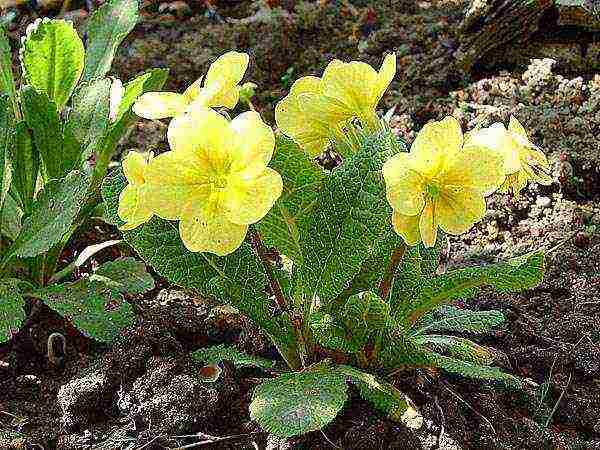
Breeding this lovely flower
Here we will talk about what a primrose flower can be. Here you will see a photo of this plant and read about how the cultivation should be. Let's start right from the garden area. The first warm spring rays stimulate the plant to awaken and it grows with numerous flower arrows. More than 500 species of primrose are known, but purple, red and blue are still recognized as popular. And yellow and white are considered rare, so some gardeners just dream of acquiring them. But this is not as easy as it might seem, the perennial primrose itself is unpretentious, but the division of its bush is very problematic. The bush has no stems, consists of a rosette with leaves and flower arrows. It grows not very willingly, and the roots are very intertwined with each other, and it is almost impossible to separate them without damage to the plant. That is why immediately planting them with seeds in pots is the best solution, so that later, with the appearance of seedlings, transplant it into the shady corners of your garden.
Further care outdoors
The first year you are unlikely to wait for the primrose to bloom, because it is capable of flowering only after 8 months from planting. So while admiring flowers should be limited to previously planted flower crops. But the next vein, they will bloom already at +10 degrees! Our primroses do not like the bright sun and will appreciate the shady flower bed with gratitude. Waterlogging also has a detrimental effect on the roots of the flower, therefore, be careful with watering. After flowering, primrose bushes do not require any additional attention, you do not need to trim them or do something else.
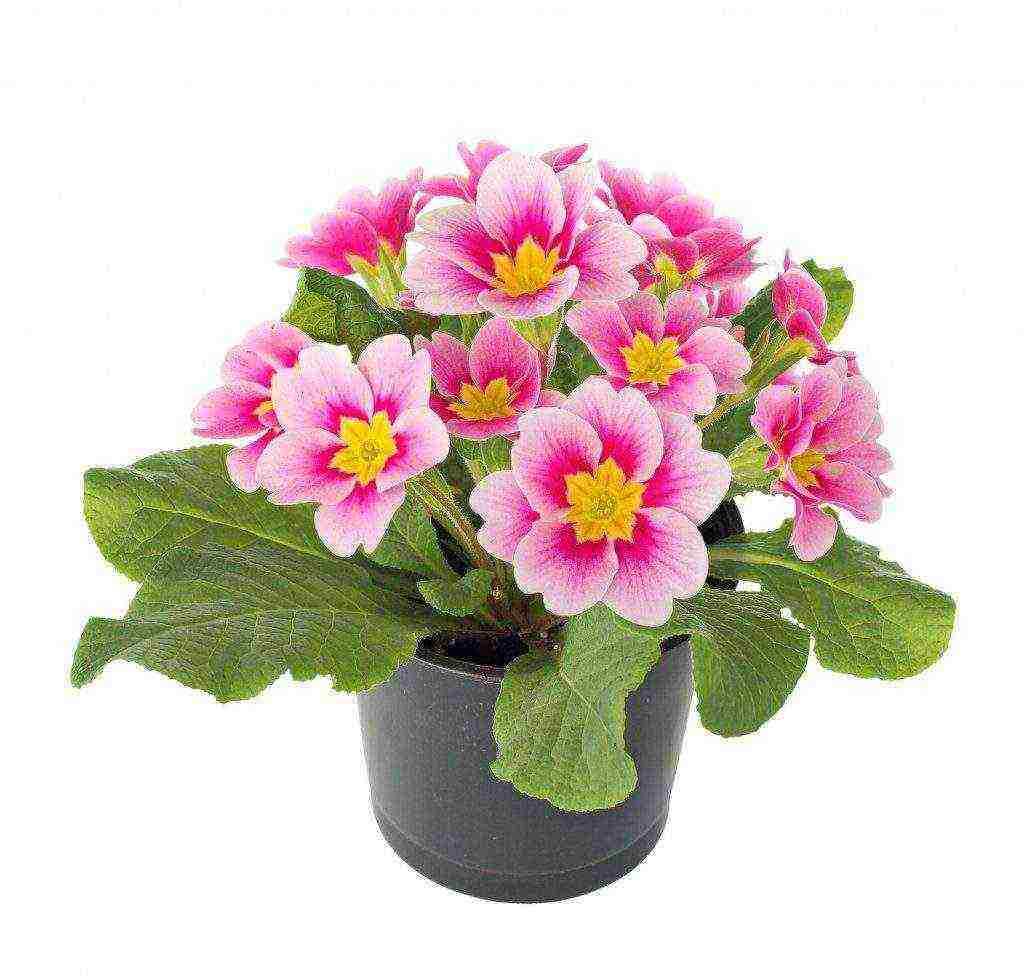
Annual primroses
If you read this article, you will find out that the technology of growing primroses is not very complicated. Primrose reproduces well by seeds, why not take advantage of this? As a rule, it is a plant with pink flowers, lush inflorescences and completely uncomplicated to care for. Some regret is the very fact that at the end of flowering, the bushes have to be thrown away, but console yourself with the thought of the next planting of seeds soon. Even about primrose - an annual, we can say that it cannot stand the heat, and at +15 it can finish flowering, but at the same time it loves humidified air.
An interesting variety is the reverse conical primrose. Growing conditions
The most suitable type for winter window sills. He has terry and lush rosettes with a color for every taste. It begins to bloom almost on the new year, so it makes sense not to delay with such a festive plant in your home.
Summer period.
Like all primroses, the reverse conical cannot stand the direct sun, but at the same time it loves to be in the fresh air, therefore, it welcomes if it is taken out onto the terrace or balcony.Do not under any circumstances dry out the soil in the pot. But waterlogging is also not the case. In the very July heat, be sure to spray the pots with the plant, or you can also place the pots in a tray with wet expanded clay. By the way, allergy sufferers need to be careful with this primrose, it can cause allergies on the hands.
Do you need any additional fertilizing for a flower in a pot? This can be done in the summer, once every two weeks. But in the period from November to February, when the buds are actively forming in the plant, this can be done every week.
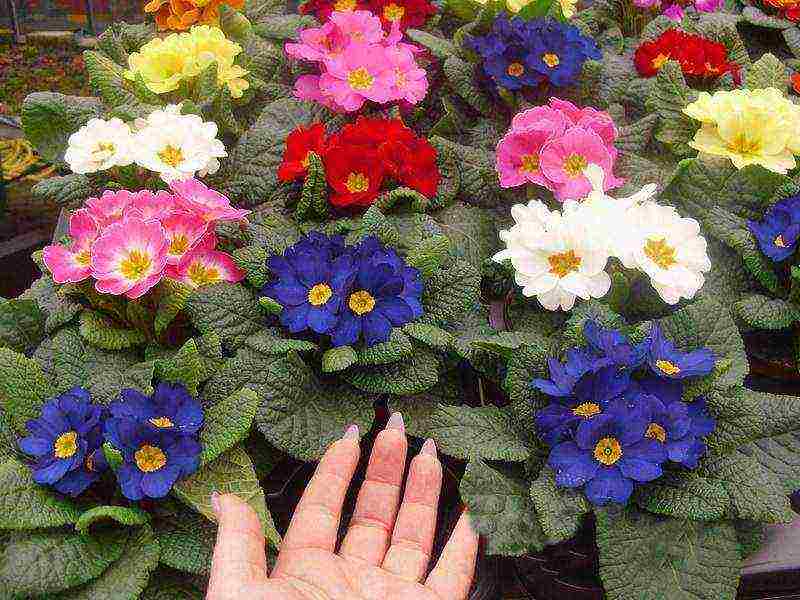
General rules for potted plants
So what is the care and planting of garden primroses? If in nature this plant is completely unpretentious, then the conditions of the pot and windowsill for its successful development will have to comply with some requirements. Here are just a few of them:
- The soil should not be oversaturated with mineral salts.
- Primroses bloom on a well-lit windowsill, but at a low temperature.
- Be sure to immediately remove dead or dried leaves for better further flowering.
- In winter, it is enough to follow 2 rules - a lit place and a stable +15 degrees indoors.
- We transplant only after flowering, drainage at the bottom of the pot is required.
Primrose is afraid of gray rot, so when fertilizing it is better to stop at products with a predominance of potassium and phosphorus. You can also treat the plant with 1% boric acid or a solution of a mixture of soap and copper.
Primrose from seeds. Sowing dates
Usually they are planted from November to December due to the time of the set of buds, but at other times of the year this can also be done. They will grow especially well if they are kept in high humidity before sowing at a temperature of +20 degrees, then after 10 days of planting, you can already wait for shoots. Now do not yawn and gradually begin to reduce the temperature and humidity in the room. The pick is carried out twice before planting in pots, usually in March - April.
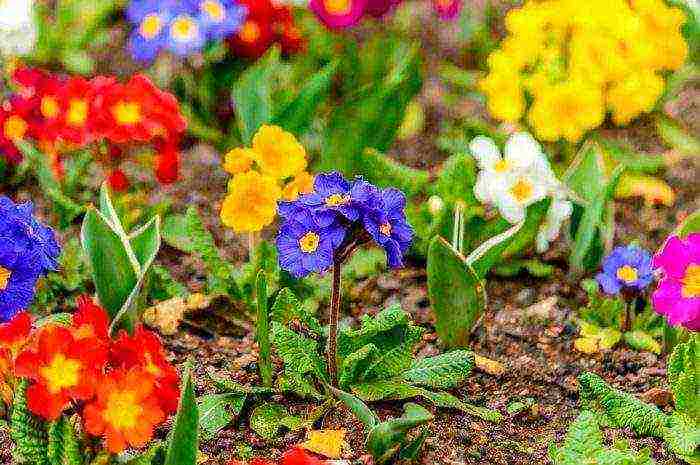
Soil selection.
We have already written about the mandatory drainage of the pot. What else does our primrose require from the soil? You can buy ready-made soil for geranium, only you have to mix it with sand 51. River sand, for example, is very, very suitable for this. For self-preparation of the soil, you will need turf, peat and foliage, mix them together and add sand 51. The pot is suitable for a spacious and at the same time low. Expanded clay is perfect for drainage.
We accelerate axillary shoots for fast reproduction.
This method is very popular with plants with a weak root system and a single leafy rosette. For reproduction, it is necessary to find a suitable cutting with a bud and part of the shoot at the base of the root collar. Although the leaves will interfere with the rooting of the shoot, all of them do not need to be removed, but only halved. We place the stalk at an angle in the prepared soil, it was described above what components it consists of. The kidney must be facing upwards. It will be quite enough to deepen 1 cm into the ground. Next, we care for the cuttings in the same way as for an ordinary adult plant. We keep them in a light, moderately warm and humid room. We protect from the direct sun.
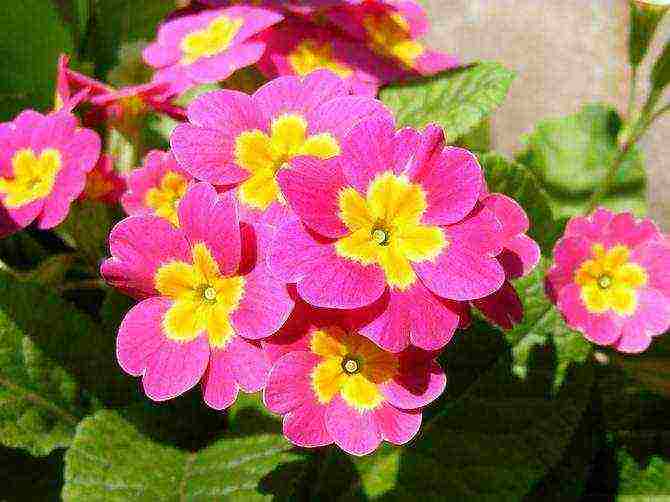
Primrose pests
Proper care and timely planting of garden primroses is not the whole secret of success. Remember that juicy and soft primrose leaves are a tasty morsel for sucking parasites such as aphids, spider mites, thrips. They are all lovers of the same warmth, so if you keep the flower cool, it will be fine, and you don't have to worry about the reproduction of pests. But if, nevertheless, they attacked your plant, then use drugs such as Actellik, Karbofos, Deci. They will save the leaves from deformation and twisting, and, accordingly, the whole plant from drying out and complete death.
But if the leaves turn yellow, then you have gone too far with fertilizing, the acidic soil is not for primroses. But you can fix the situation if you add ferrous sulfate to the water when watering.
The most beautiful varieties of primroses
Now you can learn how to grow primrose at home. Now let's talk about the popular varieties of this plant. The following varieties of this beautiful flower have become especially popular with gardeners:
- Ear primrose - cultivated in greenhouses, with velvet flowers of unusual colors, such as cream, burgundy, white, yellow. The leaves are slightly denser and thicker than usual.
- The Chinese primrose is a hybrid up to 35 cm in height, the leaves are serrated, and the eye in the flowers is yellow. Respects coolness and is suitable for growing in pots.
- Brilliant primrose - the leaves are covered with hairs, and the flowers can bloom singly, and have the colors white, pink, red and orange.
Finally
Here is a small overview on the care, maintenance and types of primrose, a flower that can delight you with its flowering almost all year round, both in the garden and on the windowsill!
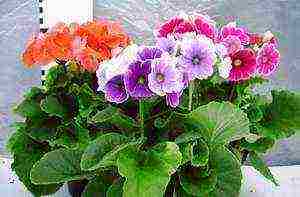 There are hundreds of varieties of houseplants. One of the most beloved species of flower growers is primrose: it has bright colors of various shades, blooms for a long time and is easy to care for. In this article, we will tell you how to grow and care for this plant.
There are hundreds of varieties of houseplants. One of the most beloved species of flower growers is primrose: it has bright colors of various shades, blooms for a long time and is easy to care for. In this article, we will tell you how to grow and care for this plant.
Primrose: general information
Primrose has about 500 species of plants of the primrose family. It got its name from the flowering time: flowers appear almost immediately after the snow melts. Wild primrose grows in the temperate zone: in Europe, Alps, Asia and North America. Indoor species can be grown anywhere in the world. They are distinguished by bright saturated colors: its flowers grow in inflorescences and have pink, red, yellow, white, blue and orange shades. The height of the bush does not exceed 25-30 cm, the leaves are distinguished by a pleasant green color.
Among all varieties, the following types are especially suitable for rooms:
-
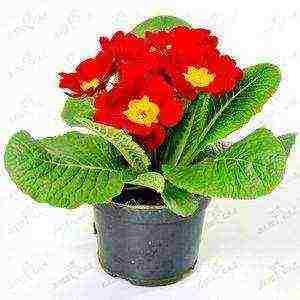 Common primrose or stemless: it has wrinkled leaves and large flowers of red, yellow and blue shades.
Common primrose or stemless: it has wrinkled leaves and large flowers of red, yellow and blue shades. - Primula soft-leaved: its homeland is China. It is an annual cultivar, reaching a height of 50 cm. It has serrated leaves up to 20 cm long and a pleasant aroma. The flowering period is in the second half of winter.
- Primula reverse conic: a perennial native to China, reaches half a meter in height. It has rounded drooping leaves and flowers of pink, red and blue. Some varieties are not poisonous and do not provoke allergies.
- Chinese primrose: grows up to 30 cm, leaves can reach 15 cm, flower diameter - 4 cm.The edges of the leaves are serrated, the flowers can be wavy. For annual flowering, it is required to organize a period of artificial dormancy once a year.
- Primrose of Chusa: has a heart-shaped leaf with a characteristic white bloom, a pleasant smell and small yellowish flowers.
Basic rules of care
Primrose, home care for which is quite easy and simple, still requires compliance with some rules.
- The plant requires a light room, but not filled with direct sunlight - windows in the west and north are well suited if there are no drafts there.
- The room should not be hot - for a primrose, the optimum temperature is 16-20 degrees. Abundant flowering can be achieved with a low temperature - no more than 16 degrees. During flowering, the temperature should be lowered even lower - up to 12-14 degrees.
-
 It is good to use a mixture of equal parts of peat, sand and leaves as a soil, you can also add sod. Good drainage must be ensured, otherwise the water will stagnate.
It is good to use a mixture of equal parts of peat, sand and leaves as a soil, you can also add sod. Good drainage must be ensured, otherwise the water will stagnate. - Watering should be moderate as the soil dries up, and you should not pour water directly on the leaves, otherwise they will begin to rot. For the same reason, spraying is completely excluded, but you can not worry about the humidity of the air - the primrose can easily cope with any.
- It is required to feed the flower once every 2 weeks.It is important to remember that feeding can only be done after the flowers have formed, otherwise the plant will throw all its strength into the growth of the leaves, and flowering will be delayed.
- As a care, it is recommended to regularly remove dry leaves and flowers, pluck dry stems.
Transplanting primrose
Home rimula requires regular replanting once a year at the end of flowering. It takes place in several stages:
- Having turned over the slides with primrose, the plant is carefully pulled out from there, trying not to damage the roots;
- Primrose roots are carefully revised and damaged or diseased ones are removed to prevent infection;
- A small amount of prepared earth is poured into a large pot;
- Then the primrose itself is installed and covered with earth to the edges, slightly crushing;
- At the end, the ground is slightly crushed.
Distillation
During forcing, primroses are transplanted into more favorable conditions to accelerate their growth and development. This is allows you to get flowers faster, but at the same time there is a depletion of roots and stems, and therefore the flowers will need a long - up to 2 years - recovery and rest. For distillation, garden primroses are used, which are more than 2 years old.
- Before freezing, primroses are dug up and, together with the soil adhering to the roots, are transferred into separate containers.
- They are stored in dark rooms at a temperature of no more than 8 degrees, without watering: under warmer conditions, they will begin to grow actively, and flowering, on the contrary, will slow down and come much later.
-
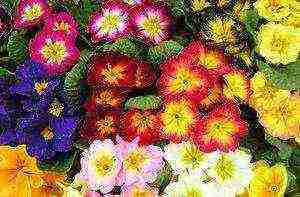 Then, at the end of January, the containers are transferred to a lighter room and the temperature is raised, but not more than +18 degrees, while they are slowly watered.
Then, at the end of January, the containers are transferred to a lighter room and the temperature is raised, but not more than +18 degrees, while they are slowly watered. - With this method, flowering begins by early spring. Forcing is often used to get the first flowers by March 8th.
- After flowering, the primrose should be transferred to a cool, bright place and watered regularly. After 1–3 years, it can be used again for forcing.
Reproduction
Growing room primrose can be done in three ways.: by seeds, dividing and cuttings. From the moment of planting to flowering, at least six months pass.
Seeds
This is a familiar method that is usually used to grow annual varieties. Depending on the selected type seeds are planted at different times: This is usually mid to late spring or early summer. For this method, a mixture of equal amounts of deciduous soil and sand is used. Seeds can be harvested every year from faded primroses or purchased.
Primrose
- The seeds are scattered over the surface, poured abundantly with water and covered with glass to create a greenhouse effect.
- After that, the pot is transferred to a cool and bright place for 1.5-2 weeks.
- When the first shoots appear, the glass can be removed, but it is best to keep the pot at a low temperature.
- Water the sprouts once a month, thin out and plant as they grow.
- After 3 months, the strongest are seated in separate small pots. When they grow up, they are transplanted into larger dishes.
Cuttings
Side branches can be used for this option. Necessary prepare a small pot in advance and pour peat and a layer of sand about 2 cm thick into it.
-
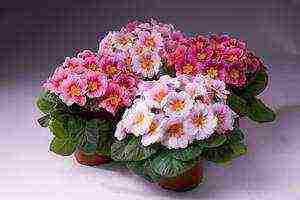 A stem with a leaf and a bud is cut off from a primrose. The sheet is cut in half, the cut line should be even, without notches.
A stem with a leaf and a bud is cut off from a primrose. The sheet is cut in half, the cut line should be even, without notches. - The petiole is planted in the ground to a depth of 1 cm at an angle and watered.
- The pot must be removed to a cool room, periodically watered.
- After about 3 months, when the petiole takes root and 3-4 leaves appear on it, it is transplanted into a larger pot. A mixture of 4 parts of deciduous soil, 2 parts of humus and 1 part of sand is used as soil.
By dividing
The method is used after full flowering of room primrose. Preliminary the plant is removed to a dark place and watered regularly. You can divide it when the stems begin to grow vigorously.
- The primrose is removed from the pot as during transplantation and the roots are examined.
- Then the bush is divided into 2-3 parts, each of which is planted in separate containers and watered.
- They are covered with transparent glass and placed in a cool room with abundant light. This should create a bathhouse effect.
- After a few days, when the plants take root and begin to grow gradually, they are transplanted into larger pots. Several transplants may be required if the containers were initially selected incorrectly.
- After each transplant, it is necessary to remove dry leaves, and also feed the primrose every half a month with mineral fertilizers.
Disease symptoms
Like any plant, indoor primrose, home care for which it is not only regular watering, it can get sick or be attacked by pests. It is easy to calculate by some external signs:
- If the leaves begin to rot, the reason is high humidity or wetness;
-
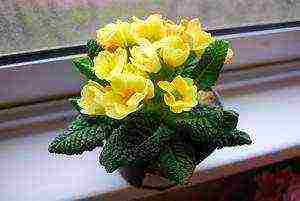 If yellowing and dryness, the problem may be too dry air, excess fertilizer or water;
If yellowing and dryness, the problem may be too dry air, excess fertilizer or water; - If the primrose does not bloom or quickly fades and drops flowers, it is worth checking the air temperature (it should not be higher than 16 degrees);
- Among insects, primrose often suffers from aphids, weevils and spider mites, among diseases there is spotting. The latter manifests itself in the form of light gray spots on the leaves, which are then covered with bloom. To get rid of them, it is necessary to completely remove the infected leaves and sprinkle the primrose with a solution of Fundazol or Topsin.
Important
It must be remembered that primrose leaves are poisonous, and primrose itself can cause irritation and allergies. Having finished caring for the flower, you must thoroughly wash your hands, work with it should be carried out with gloves. It is not recommended to put the plant in the nursery so that the baby does not pull the flower into his mouth and does not get poisoned.
Conclusion
Primrose is unpretentious home flower that will not cause trouble for the owners... It takes root well in cold climates and will delight with beautiful flowers for a long time.
Rate the article:
(17 votes, average: 4.4 out of 5)
Primrose belongs to the Primroses family. These are low-growing herbaceous plants with beautiful flowers. Their name comes from the Latin word primus, which translates to "first". Primroses begin to bloom without waiting for the snow to completely melt. Garden plants have successfully moved into the house. Indoor primrose is popular among flower growers due to its bright flowering and easy care.
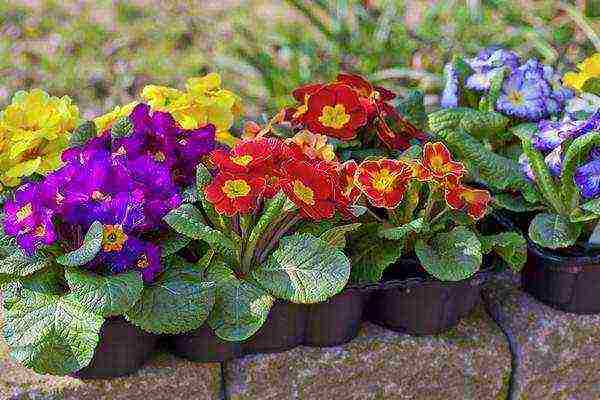 Indoor primrose
Indoor primrose
The primroses family has more than 500 species. Most of them grow in gardens and natural conditions. Plants are found in Europe, North America, Asia. A brightly blooming culture is grown not only to decorate the garden, but also at home. Primula is a low-growing herb. Among them are annuals and perennials. Breeders are constantly working on the development of new varieties. Thanks to their efforts, indoor primroses with double flowers appeared, such as in the photo.
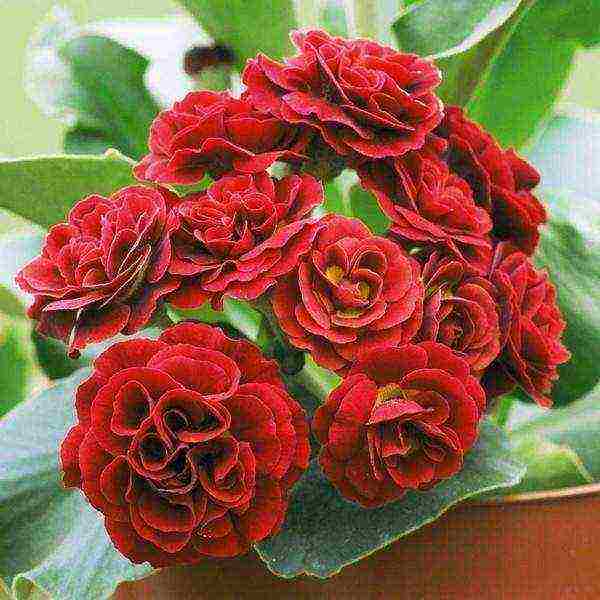 Crimsonglow
Crimsonglow
The root system of primroses is fibrous, the stems are short, the leaves are often pubescent. Coloring pleases with pastel and bright shades. Umbrella inflorescences look attractive over a rosette of green leaves. The bud consists of five petals, regardless of the color of the pharynx, most often yellow. The shape of the leaves is round or medullary; they grow on long petioles. The edges of the leaf plate are wavy or serrated, the surface is wrinkled.
Beneficial features
The leaves of the plant contain vitamins, carotene, polysaccharides, amino acids. They are added fresh to spring salads. Decoctions are made from the dried parts to help with bronchitis and other respiratory diseases. The agent helps to remove phlegm, acts as a sedative. The roots of primroses contain essential oil.
Types of room primrose
Among the many types of primroses for growing in pots, several were chosen:
P. soft or soft-leaved (Primulamalacoides)
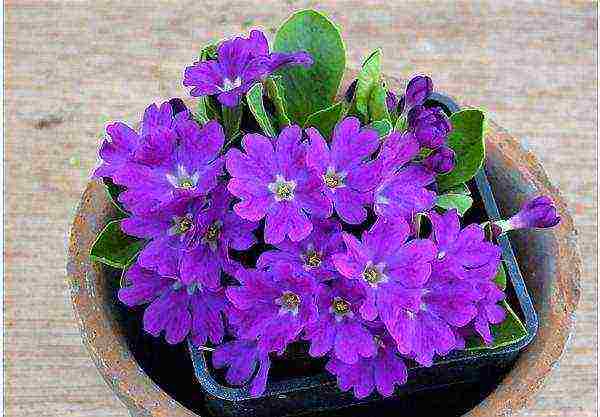 P. soft
P. soft
This species of primrose has oval-shaped basal leaves. The leaf plate is light green, the edges are serrated. On the bush there are several peduncles with whorls of 10-20 fragrant flowers. The color is white, red, pink. The culture blooms from winter to spring.
P. cuska (Primulakewensis)
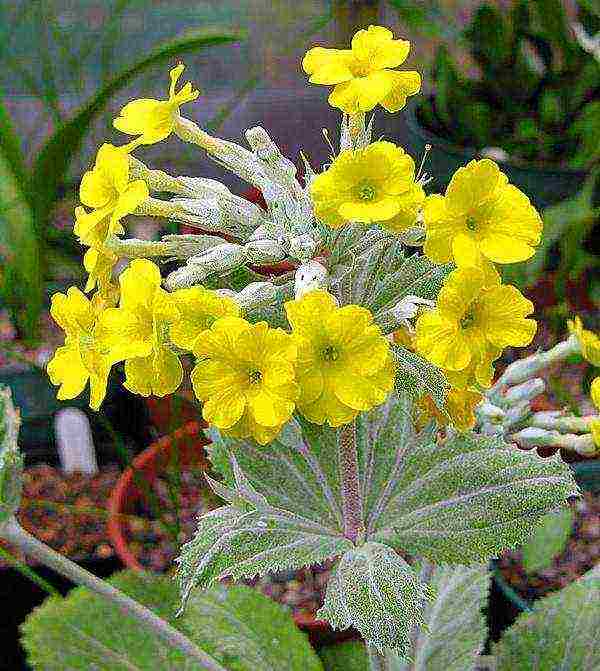 P. cusky
P. cusky
Herbaceous perennial with core-shaped rosette leaves. There are varieties of pubescent and non-pubescent, in the first case, cover the plant with a white bloom. Leaves are green, wrinkled, with a jagged edge. On long peduncles (up to 30 cm), flowers with a long tube reach 2 cm in diameter. The color is yellow. The plant has a pleasant smell.
P. Chinese (Primulachinensis)
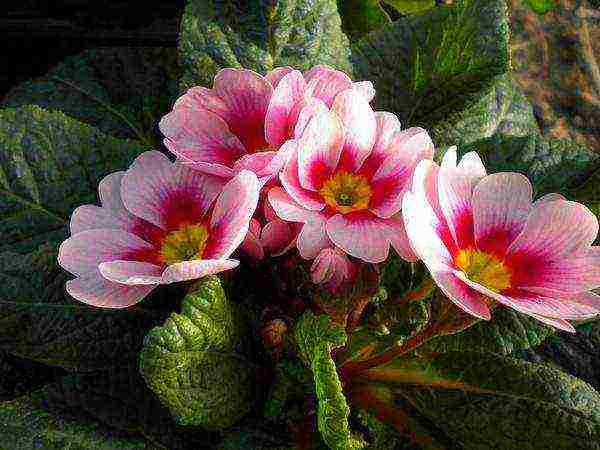 P. chinese
P. chinese
The primrose has large, rounded leaves with jagged edges. Flowers with wavy petals are collected in umbrella inflorescences. The plant is popular in England, local breeders have developed many varieties, which are divided into three large groups:
- simple large-flowered;
- terry;
- with flowers in the form of a rose.
P. reverse conic (Primulaobconica)
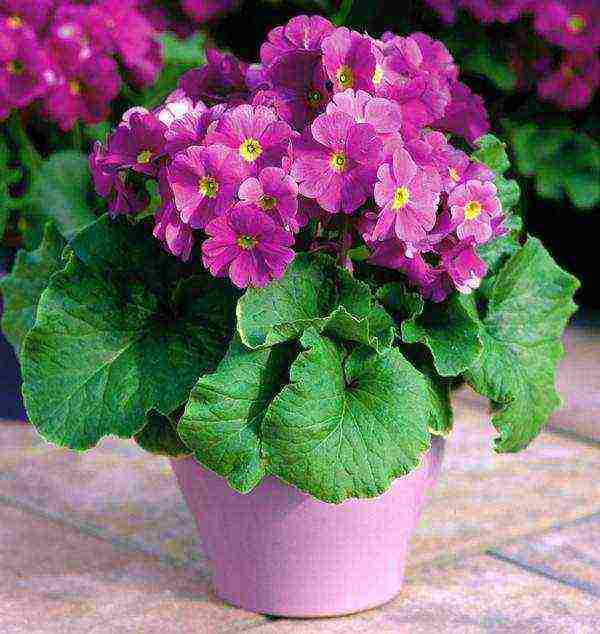 P. reverse conical
P. reverse conical
The obkonika or reverse conical primrose came to Europe from China in 1880. Leaves are rounded, long-petiolate, wavy at the edges. The plant is covered with white hairs to varying degrees. Numerous flowers are collected in umbellate inflorescences, the diameter of which is 7-8 cm. Coloring - various shades of purple, pink, red.
Attention. Primrose pubescence contains the chemical primin, which causes an allergic skin reaction.
P. ordinary or stemless (Primulavulgaris)
 P. ordinary
P. ordinary
A common type of garden primrose is successfully grown indoors. On sale it is called akaulis. The plant is small, the height of the bush is 20 cm, flowers 3-4 cm in size are attached to separate peduncles. The leaves are bright green. Hybrid varieties have a variety of colors: pink, white, red, but the throat is usually yellow.
Among the potted primroses, akaulis has become the most popular. This was facilitated by the huge variety of shades and forms of hybrid plant varieties. Long blooming also played a role - from December to May. The flower is unpretentious and resistant to low temperatures. It can be grown in balcony containers. Akaulis loves shade and coolness.
 Akaulis Care features
Akaulis Care features
Care advice depends on the type of primroses. Indoor plants are annual and perennial, soft-leaved primrose belongs to the first group, and obkonika belongs to the second. Annuals do not survive after flowering, do not require transplantation. Indoor primroses are more sensitive to cold, but some varieties do equally well outdoors and indoors.
Temperature and lighting
Primrose is comfortable in a cool room with a temperature of 18-20 °. During the flowering period, it is desirable to lower the temperature to 14-15 °. In early spring, the plant is taken out to the balcony or veranda, fresh air is good for it. In winter, the flower should be kept away from heating appliances. Direct sunlight is contraindicated for primroses. The best place for them would be east or west windows. Primrose will take root on the north side. In winter, the lack of lighting is compensated for by a fluorescent lamp.
Advice. If you cut off the peduncles immediately after the petals wither, then the flowering period can be extended by 2-3 months.
Soil selection
The shops sell special soil for growing primroses. It contains all the necessary components in optimal proportion. Purchased substrate is not the only option; if desired, the soil is formed independently. This will require in equal proportions:
- peat;
- leafy land;
- sod land;
- sand.
For large-flowered varieties, a pot with a diameter of 10-11 cm is recommended, for small-flowered varieties - 7-8 cm.At the bottom of the container, a drainage layer of small pebbles or expanded clay must be poured.
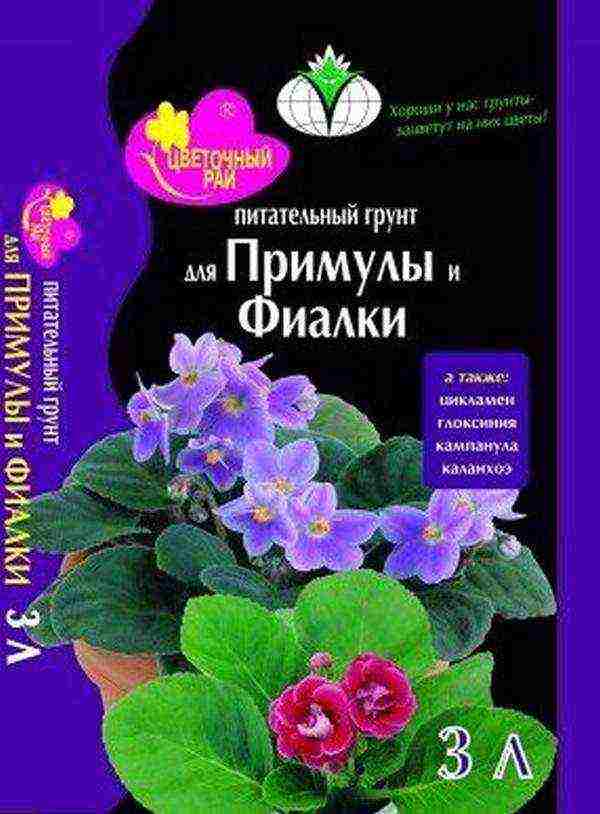 Soil for primroses
Soil for primroses
Watering
An important point in caring for room primrose at home is moisturizing. Water the plant regularly, but in moderation. The soil should not dry out. For irrigation, settled, rain or melt water is used. During flowering, primrose requires more moisture, during the dormant period, the intensity of watering decreases.
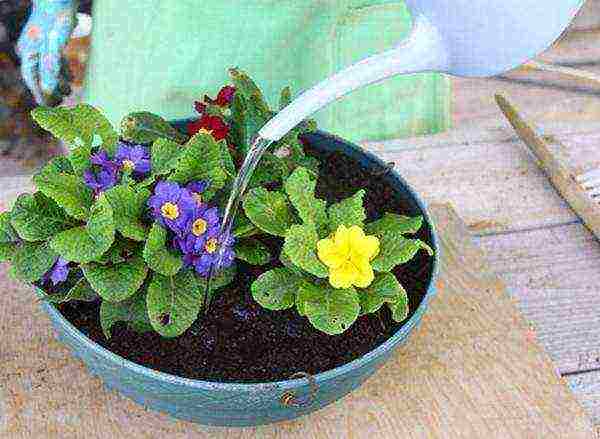 Watering primroses
Watering primroses
The plant is sensitive to indoor humidity levels. During the heating season, it is necessary to find an opportunity to maintain air humidity. In addition to special moisturizers, simple and affordable products are used. A pot of primrose is placed in a tray filled with moss, sand or expanded clay. The filler is periodically moistened.
Transfer
Perennial indoor primroses require a transplant once a year. This stimulates the growth and flowering of the plant. The pot should be slightly larger than the previous one. It should be wide, but not tall. In order not to damage the roots, the flower is transplanted by the transshipment method. New soil is poured into voids that are not filled with soil on the roots. After planting, the primrose is watered. The best time for the procedure is the beginning of autumn.
Attention. A hybrid variety of primrose obkonik "Stroke me" does not cause allergies.
Plant diseases
Primroses have strong immunity. Failure to comply with agrotechnical recommendations leads to the appearance of diseases in room primrose. With abundant moisture, rot appears on various parts of the plant. Fungal infection is manifested by the appearance of brown spots and plaque. The buds dry and fall off. The flower is treated with fungicides. Affected leaves are destroyed. Common diseases include:
- spotting;
- root rot;
- powdery mildew.
Indoor primroses rarely infect insect pests. One of the few enemies of the flower is the spider mite.
Growing from seed: step by step 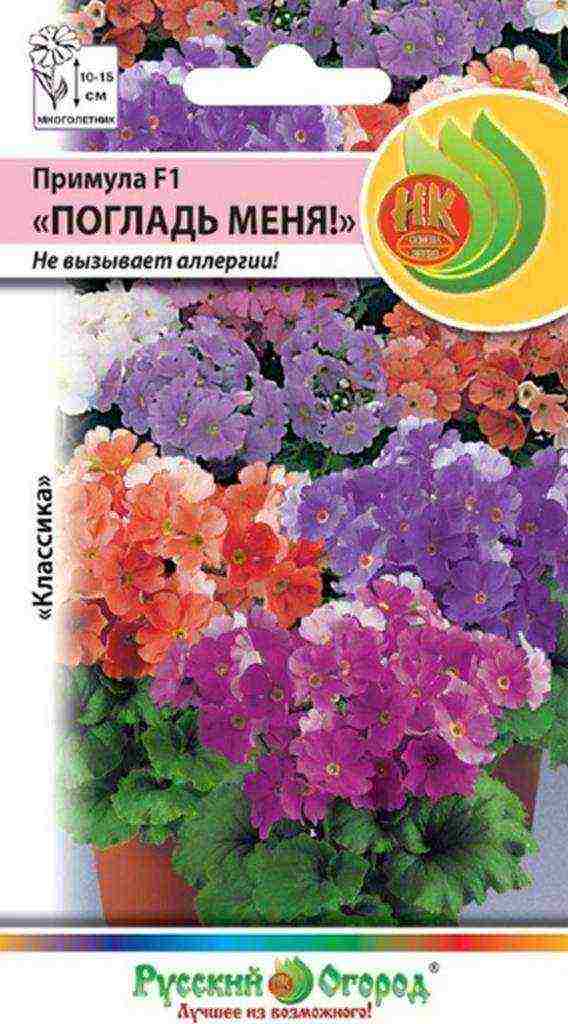 Non-allergenic hybrid seed
Non-allergenic hybrid seed
Reproduction of primroses occurs in various ways:
- by dividing the bush - the perennial, along with the roots, is cut into several parts;
- by cuttings - the cutting is cut off and rooted in the soil;
- seeds - seed material is collected and planted in containers with fertile soil.
Growing primrose from seeds at home is a troublesome and time-consuming method. Thousands of seeds ripen in the capsules of the plant, but during storage they quickly lose their germination. Store them at a cool temperature. Sowing seeds is recommended in summer. Wide containers are used for cultivation. The soil should be loose and nutritious. The addition of perlite or vermiculite will improve its structure.
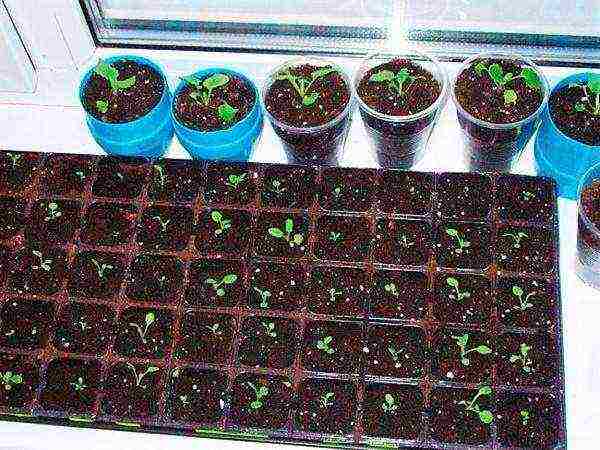 Young sprouts
Young sprouts
Before planting, room primrose seeds are moistened. A large amount of material is distributed from a napkin, individual grains are laid out with a toothpick. The sowing is moistened and covered with a film to create greenhouse conditions. The container should be kept in a cool room with a temperature of 16 °. The sprouts will appear in 2-3 weeks. During this period, the greenhouse is watered and aired. With dense seedlings, a pick is carried out. After 1.5 months, the grown seedlings are distributed in pots.
Moscow, Russia, on the site since 11.01.2017


